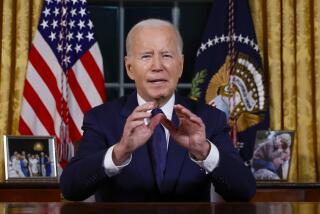A U.S. Policy Filled With Outdated Notions
WASHINGTON — When Washington’s foreign policy gets stuck, its emissaries take to the road. Little wonder, then, that President Bill Clinton heads to South Asia today. Few regions offer such a dazzling array of seemingly unsolvable problems: nuclear politics, civil wars, short-lived governments and occasionally cranky participation in the global marketplace. But Clinton’s short week of photo opportunities--and the chance to play suitor, umpire and confessor--is designed to reinforce America’s frustratingly short-term, reactive and backward-looking attitude toward the subcontinent. Without a new South Asian agenda, Clinton’s era of good feeling will be brief, indeed.
Spectators of the itinerary jousting that occupied Washington’s South Asia hands might mistake this walk into the 21st century for a road to 1950. Then, as now, U.S. policy is captured by the same Indo-Pakistani disputes, against which it periodically remonstrates but intermittently encourages. Then, as now, Washington feels obliged to choose between neighbors whose one commonality is a shared disinclination to get along. Then, as now, stereotypes, sermons and sanctimony color political commentary: India is the world’s largest democracy and should be a natural ally; Pakistan occupies a vital strategic space in an unstable region; Bangladesh’s plucky politics prove social investment can arrest poverty. Terrorism is bad, tolerance is good and trade is best of all. With prose so polished, why travel?
Well, these relationships haven’t worked so well. Fifty-three years after gaining independence, neither India nor Pakistan can claim a healthy, happy, durable relationship with the United States. Month by month, they dance an intricate arabesque around the piecemeal demands that substitute for clear U.S. policy. Countless hours and dollars are spent avoiding sanctions: terrorism lists, narcotics lists, nuclear lists, technology lists--the repetitive benchmarks on the road to global engagement are the stuff of minute negotiations, not broad cooperation. Congressional demands, publicly derided but privately embraced by many U.S. diplomats, have made pedantry and punishment the hallmarks of U.S. policy. Diplomacy by checklist is good business, but only for lobbyists.
For one fleeting moment in its early years, the Clinton administration tried to separate itself from South Asia’s enmities and rise above the pettiness that plagued post-Cold War policy. It counseled nuclear restraint, encouraged cross-border trade and sought collaboration, within the region and beyond it. But it couldn’t match the subcontinent’s adherence to habitual one-upmanship and couldn’t be bothered to learn how to view the world through Asian eyes.
The U.S. simply didn’t have the patience, stamina or interest to stick it out: The long-term was just too far away. But while Washington wasn’t looking, bombs proliferated, wars erupted, governments fell, and old-fashioned U.S. hectoring rejoined South Asia’s practiced rivalries.
But not entirely. India is now a player in the global information economy, and U.S. entrepreneurs have set their sights on its rising middle class, some 250 million strong. Indian Americans have calculated the fine arithmetic of influence in their substantial contributions to U.S. political coffers, and vote regularly. So do Pakistani Americans, but their homeland is a disheartened sideshow on this tour. Burdened by a military ruler whose strenuous efforts to bring Clinton to the Islamabad airport transformed a gracious invitation into a demand for undelivered validation, Pakistan’s internal problems have become the tacit model of failure against which the Clinton administration measures India’s economic successes. Even Bangladesh, the unwitting beneficiary of frequent-flyer diplomacy, is laying claim to an improving, export-driven economy.
Profit, not politics, is the acknowledged incentive for U.S. policy, and rather unusually, the U.S. is selling itself as both consumer and producer, like India. Washington even spiced pretravel speeches with a taste of pandering: Lamenting past policy differences, Secretary of State Madeleine K. Albright apologized to India last week for the “unnatural and regrettable” estrangement of past eras.
Right subject, wrong object. If apologies are in order, they are not due to those who overcame past inequities, but to those who cannot surmount current inequities. For far too long, the yawning chasm of the Cold War swallowed South Asia’s economic resources, turning plowshares into swords and fueling wars without winners. Cheerleaders in Washington, London, Riyadh and Beijing helped finance battles and border skirmishes. Almost every country in the region has had to shape its development around threats to peace and recovery from war. Long-running conflicts in Afghanistan and Sri Lanka still place the entire region at risk.
Americans view South Asia through a split screen: computer terminals to the left, sectarian riots to the right. They rarely connect the dots to draw an accurate portrait: poverty coexisting with prosperity, despair with opportunity, dictatorship with democracy. These are not theoretical equations, but the stuff of which daily life is made.
The human cost of progress is therefore tied to the region’s political future. South Asia is a place where schoolchildren and peasants compare the costs of guns and textbooks without prompting from think tanks. While bureaucrats bicker about the accumulation of small things, the region’s 1.3 billion residents confront big questions: Who will find food, shelter and water for rapidly growing populations? How can India cope with the 750 million citizens who live in poverty? Who will ensure that nuclear playthings are locked up where they can’t frighten everyone to death? Who can govern in such a complex environment?
These questions define South Asia’s future--and the world’s. They challenge the assumptions of public policy and diplomacy. The tired old Western models of development are irrelevant to this agenda. State boundaries, vigilantly protected by modern armies, are hindrances in the struggle to secure clean air and water. Conventional development wisdom--industrialize first, clean up later--consigns the region to a global dustbin. Having spent a half-century fighting for national sovereignty, South Asia’s citizens might soon conclude that economic imperatives will require far looser sovereignties and more refined regional governance. Their current leaders, among them, the products of divisive politics and praetorian pretensions, are likely to find this agenda daunting, as well they should.
Judging by Clinton’s itinerary this week, the U.S. is planning to be left behind as South Asia endeavors to define its future. Fashioning itself as the world’s protector elsewhere, the U.S. may well find that in South Asia it is protecting a version of global governance that is sadly devoid of political vision. *
More to Read
Sign up for Essential California
The most important California stories and recommendations in your inbox every morning.
You may occasionally receive promotional content from the Los Angeles Times.










